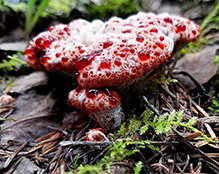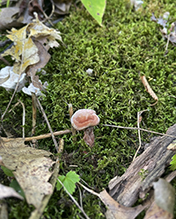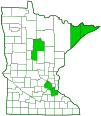Red-juice Tooth
(Hydnellum peckii)
Conservation • Description • Habitat • Ecology • Distribution • Taxonomy
Conservation Status |
|||
| IUCN Red List | not listed |
||
| NatureServe |
|
||
| Minnesota |
|
||
Description
Red-juice Tooth, also called Bleeding Tooth, is a common and widespread toothed fungus. It occurs in Europe and North America. In the United States it occurs in the east from Maine to Florida, west to eastern Minnesota and Alabama, in Colorado, and west of the Rocky Mountains from Washington to central California. It is uncommon in Minnesota, where it reaches the western extent of its eastern range. It is found in late summer and fall, in coniferous and mixed forests, alone, scattered, in groups, or in clusters. It grows on the ground under conifers. It has a mutually beneficial relationship (mycorrhizal) with the tiny rootlets of trees, absorbing sugars and amino acids while helping the tree absorb water.
Red-juice Tooth is easily recognized when young. When it first appears the fruiting body is top-shaped and white to pink. The upper surface is moist and is densely covered with felty or velvety hairs. As it ages the cap expands, becoming broadly convex to flat. It grows around whatever it touches and it is often embedded with plant stems, pine needles, or other debris. When growing in clusters, adjacent caps fuse together, making it difficult to distinguish individual fruiting bodies. The upper surface exudes droplets of bright ruby red or dark red liquid. Mature caps are 1″ to 6″ (2.5 to 15.0 cm) in diameter, depressed in the middle, lumpy, jagged, or ridged, and sometimes pitted. The upper surface is hairless, scaly, and brown, dark brown, or reddish-brown in the center, pale around the margins. Older caps are almost entirely a dark shade of brown.
The underside of the cap, the spore surface, is covered with short, spine-like teeth. The teeth are 1⁄32″ to ¼″ (1 to 6 mm) long and dull pinkish at first, soon becoming brown or purplish-brown, sometimes with pale tips. The pore surface sometimes runs down the stalk.
The stalk is solid, tough, 3⁄16″ to 3″ (0.5 to 7.5 cm) long, and ⅜″ to 1¼″ (1 to 3 cm) thick. It may be connected centered or off-centered to the cap. It is colored like the cap or darker than the cap, and it is covered with fine felty or velvety hairs.
The flesh is tough, corky, and insubstantial. The taste has been described as "burning-acrid”, “very hot”, and “intensely peppery”. All of which makes this fungus inedible.
The spore print is dull brown.
Similar Species
Habitat and Hosts
Coniferous and mixed forests. Conifers.
Ecology
Season
Late summer and fall
Distribution |
||
|
Sources Biodiversity occurrence data published by: Minnesota Biodiversity Atlas (accessed through the Minnesota Biodiversity Atlas Portal, bellatlas.umn.edu, 10/10/2025). |
|
| 10/10/2025 | ||
Occurrence |
||
|
||
Taxonomy
Kingdom
Fungi (Fungi)
Subkingdom
Dikarya
Phylum
Basidiomycota (Basidiomycete Fungi)
Subphylum
Agaricomycotina (Higher Basidiomycetes)
Class
Agaricomycetes (Mushrooms, Bracket Fungi, Puffballs, and Allies)
Order
Thelephorales
Family
Bankeraceae
Genus
Hydnellum
Family
iNaturalist.org notes that the family Bankeraceae has been split, with four genera, including Hydnellum, moving to the new family Sarcodontaceae. They do not give a source for the split. Index Fungorum, MycoBank, GBIF, and Catalogue of Life all list Sarcodontaceae as a synonym of Bankeraceae.
Subordinate Taxa
Synonyms
Calodon diabolus
Calodon peckii
Hydnellum diabolus
Hydnellum rhizopes
Hydnum diabolus
Most sources, including Index Fungorum MycoPortal, and GBIF, treat Hydnellum diabolus as a synonym of Hydnellum peckii. Some, including MycoBank and iNaturalist, treat it as a valid species.
Common Names
Bleeding Hydnellum
Bleeding Tooth Fungus
Devil’s Tooth
Red-juice Tooth
Strawberries and Cream
Glossary
Mycorrhizal
A symbiotic, usually beneficial relationship between a fungus and the tiny rootlets of a plant, usually a tree.
Visitor Photos
Share your photo of this fungus.
This button not working for you?
Simply email us at info@MinnesotaSeasons.com.
Attach one or more photos and, if you like, a caption.
Gary Walton |
 |
Hydnellum peckii (Bleeding Tooth) … Hydnellum peckii (Bleeding Tooth) found in a jack pine stand near the Temperance River off the Sawbill Trail in Cook County. |
Honey Fae (Farah) |
 |
MinnesotaSeasons.com Photos
|

Slideshows

Visitor Videos
Share your video of this fungus.
This button not working for you?
Simply email us at info@MinnesotaSeasons.com.
Attach a video, a YouTube link, or a cloud storage link.
Other Videos
Bleeding Tooth Fungus ; Hydnellum Peckii Explained
Mushroom Wonderland
The Bleeding Tooth Fungus; It's Like Something From A Horror Movie
Papa Ray's Adventure Channel

Visitor Sightings
Report a sighting of this fungus.
This button not working for you?
Simply email us at info@MinnesotaSeasons.com.
Be sure to include a location.
M
9/26/2023
Location: Sawbill Campground, BWCA
I saw a large clump on a downed rotting tree. Orangish top. Slimy thicker stalk and cap. Appearing to be bleeding. Looks like the one in your picture
Gary Walton
8/7/2019
Location: Cook County
… Hydnellum peckii (Bleeding Tooth) found in a jack pine stand near the Temperance River off the Sawbill Trail in Cook County.
MinnesotaSeasons.com Sightings |
|



